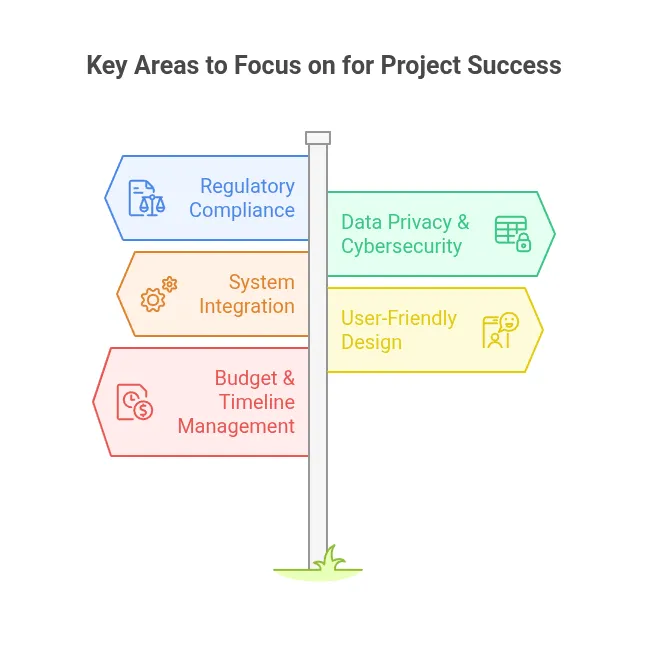Table of Contents
Healthcare software companies are playing a major role in transforming the healthcare industry.
Healthcare software development is the solution to major problems like manual and repetitive administrative paperwork, medical care for remote patients, etc.
Software development for healthcare apps comes with many challenges, and healthcare software companies need to overcome these challenges.
Let’s talk about how healthcare software development solutions tackle the challenges faced by healthcare.
Meeting Regulatory Compliance (HIPAA, GDPR)
Problem: Meeting regulatory requirements is one of the biggest challenges of healthcare software design.
HIPAA (Health Insurance Portability and Accountability Act) in the USA and GDPR (General Data Protection Regulation) in the EU, these regulations provide guidelines and govern how patient data is collected, stored, and shared, making non-compliance a costly legal risk.
Solution:
- Integrating security protocol by design from the start of development.
- Working with legal consultants who are familiar with local and international compliance laws.
- Conducting regular audits to ensure the healthcare software remains compliant even after updates.
- Various encryption protocols and giving access controls to only authoritative and necessary individuals.
Handling Data Privacy and Cybersecurity
Problem: Increasing amount of cyber attacks, ransomware and data breaches in the healthcare industry.
In the healthcare software development process, protection to sensitive data of patients is necessary, else a data leak can destroy the reputation of the organisation.
Solution:
- Using advanced encryption methods for data in transit and at rest.
- Implementing multi-factor authentication (MFA) for all users.
- Conducting regular vulnerability assessments and penetration tests.
- Updating software and patching up known vulnerabilities whenever required.

Managing System Integration and Legacy Systems
Problem: Outdated databases and systems.
Many healthcare organizations need to integrate new healthcare software solutions with the legacy systems they have, which can be very complex and very risky if not done correctly.
Solution:
- Using APIs like HL7 (Health Level Seven) or FHIR (Fast Healthcare Interoperability Resources) to facilitate data exchange.
- Planning for phased rollouts to minimize disruptions.
- Create custom middleware to bridge the gap between old and new systems.
- Ensure thorough documentation and team training during migration.
Designing for Non-Tech-Savvy Users
Problem: A Complex interface will lead to improper use of it.
Healthcare providers and patients may come from non-tech-savvy backgrounds, leading to confusion, patient dissatisfaction, poor adoption, and medical errors.
Solutions:
- Healthcare software design should be more user-friendly.
- Conduct interface tests with real end users like patients, nurses, and doctors.
- Make the interface user-friendly with clean, simple, and easily readable large buttons, fonts, and clear icons.
- Include advanced features like voice command for hands-free use, multi-language support for non-English speakers, and screen reader compatibility.
Budget and Timeline Management Tips
Problem: Software development in the healthcare industry can be expensive and time-consuming.
Healthcare software companies require time and money to create a healthcare app that aligns with your organization.
Solution:
- Start with a Minimum Viable Product (MVP) to integrate and validate core features.
- Use Agile methodologies for flexibility and faster iteration.
- Partition the Healthcare software development process into quantifiable milestones.
- Have deep and meaningful conversations with stakeholders, developers, and testers to have a clear understanding of your goals.
Conclusion
While the challenges in software development for healthcare apps are considerable, they are not insurmountable.
With the right strategy, technology, and team practice, healthcare software companies can build secure, compliant, and user-friendly software that makes a real difference.
Partnering with the right healthcare software development company can help you stay ahead of the game and deliver solutions that revolutionize patient care.
FAQ
Q1. What are the biggest challenges in developing healthcare software?
The top challenges include meeting regulatory compliance (e.g., HIPAA, GDPR), handling data privacy and cybersecurity, managing system integration and legacy systems, creating a friendly user interface for non-tech-savvy users, and managing project costs and timelines.
Q2. Why is compliance important in medical software?
Compliance ensures that patient data is handled securely and legally, reducing the risk of legal penalties and data breaches.
It also builds trust with users and patients, which is critical in the healthcare industry, as there is a rise in cybercrime.
Q3. How to handle data privacy in healthcare applications?
To protect data privacy:
– Encrypt data at all stages.
– Restrict access based on roles and necessity.
– Use secure servers and regularly update your software.
– Follow strict regulatory guidelines like HIPAA or GDPR, depending on your region.